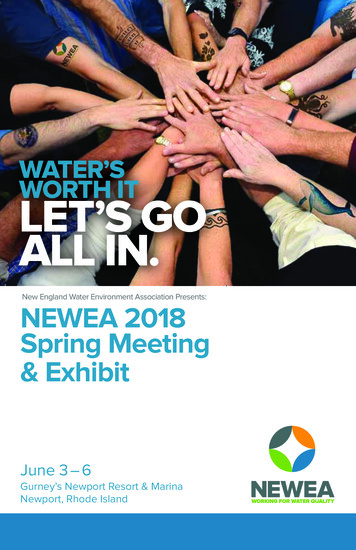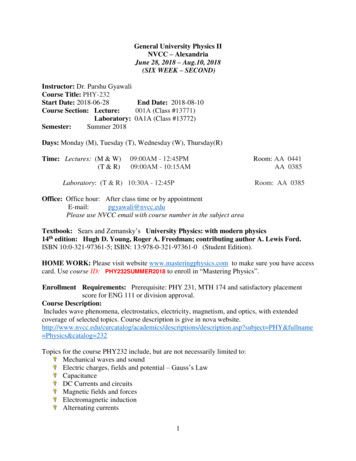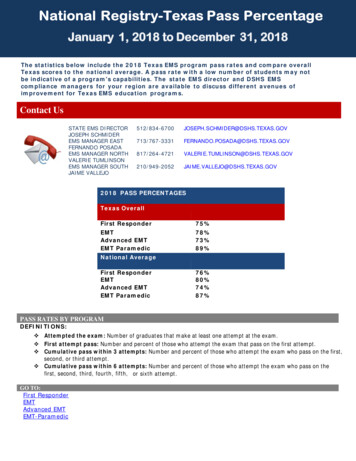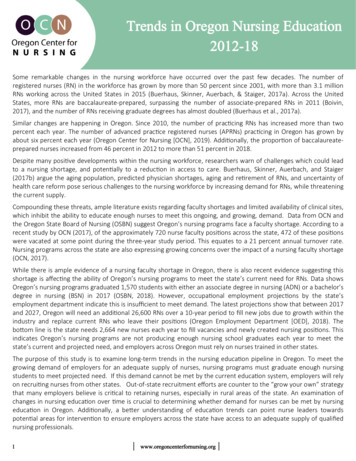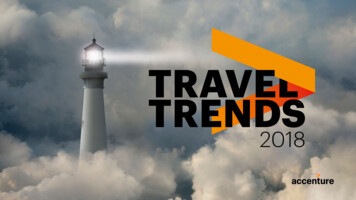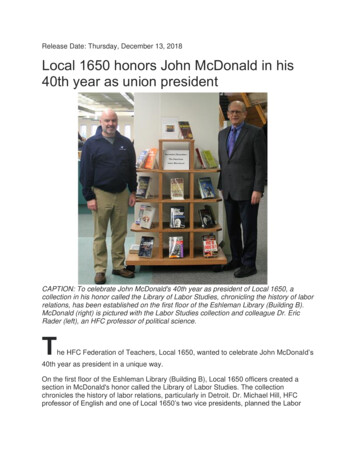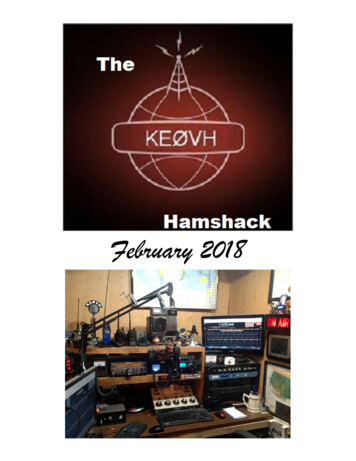
Transcription
February 2018
Greetings, Happy FebruaryLots of pictures to show you this month. So let’s get started! BE SURE to see the last story though!It is a real kicker!OK! I did it! Last of January I passed the Part 107 Remote UAG Pilots Exam! I am really excited at thisaccomplishment and look forward to operating both my and the company’s DJI Phantom 3’s for fun and forwork. Thanks to Sam and Jeremy for the help and encouragement in getting this certificate. There are a greatmany study materials available on Amazon.com and the apps on the I-stuff.There are a lot of rules pertaining to flying drones both as a recreational hobbyist and for commercial use suchas inspecting towers and other tall structures, real estate, etc. A lot of people for instance on YouTube areposting videos that are just downright dangerous and even reckless without understanding and adhering to theFAA rules about airspace and safe operation. And of course in todays world there are apps that you can haveon your phone to assist you in know where you are in the National Airspace, altitudes to safely (and legally flyup to) operate your drone. See the FAA’s “B4UFLY”. For instance there is a drone ceiling rule of no higherthan 400 feet above ground level, unless flying within a 400 foot radius of a structure, then NO higher than 400feet above the highest point of that structure. You must notify airports and heliports of your flight if within 5miles of said facilitiy. NO flying over people unless they are inside a structure or automobile unless they arepart of “your crew”. VLOS, which means “Visual Line of Site”. You must be able to see your drone with thenaked eye, no binoculars for primary visual tracking, etc. So on an so forth. Even with a lightweight drone. Sobefore you fly, do know what you are doing! I recommend 2 study guides that I used, check this link t-Prep2018/dp/1619545594/ref sr 1 1?ie UTF8&qid 1517499493&sr 8-1&keywords remote pilot study guide“TestPrep” is only around 14, and INCLUDES 5 online (very accurate) practice tests. The other app on myIpad I used is called “FlighReady”. It costs around 24. But with these I was ready to go.After passing the test at an FAA facility here in Denver at Centennial Airport (registration is fairly simple but canbe confusing), you must then apply for the license via the IACRA FAA website. That again took a littleunderstanding from the FAA “helpdesk”. I have the official directions on what to do so email me if youwould like a copy.
! Check out this video of a 737 flight simulator that a guy in Britain built in his outside garage.https://www.youtube.com/watch?v FV8PMwbGh08And this inside a garage! Pretty amazing!https://www.youtube.com/watch?v J5BmA3ejyHYNear Denver, a 1000 foot tower demolition:https://www.youtube.com/watch?v 9mE0Z9 G3U&feature youtu.beI made a ham radio shack video a few years back, you can see an old version of “The KEØVH Hamshack” in this video onYouTube from 2008! See it at https://www.youtube.com/watch?v kHhLYk7BiSU at about the 3:05 point in the video.Everything there is long changed out except the D-104, the code key and headphones, and the Heil mic!Here is the KEØVH AllStar Node 46020 in the Lakewood office. Keeping in touch with hams across the country directlyvia the simplex repeater here. Holler at me sometime via the node. Shane KØSDT has a node up and operating soon.We continue to grow this system and as you can see here it is connected to the Sky System hub node 46079 which inturn is connected to several other nodes, including the N6JER system in Rocklin CA. If you have any questions or needsome help setting up your own node let us know. You can use an older computer or a Raspberry Pi and downloadableimages to get started on your node.
And here is Skyler Fennell KDØWHB , our AllStar guru and EMF Contractor talking to the NOC and calibrating one ofour stations in Colorado. Skyler is a great help for all things AllStar, and runs several nodes including the KC5OROSocorro New Mexico node where he is a student at the university there.I found a buyer for the 1954 Admiral TV that I have had for a few years that came from Glenn, WNØEHE for myself andGreg WB7AHO to restore. Greg did a great job in replacing tubes, capacitors, and doing alignment procedures to get theset operating and fully functional again. The TV now has a home outside of Phoenix in a home that is dedicated to allthings 50’s! No kidding. The new owners were so excited to find this set and I am really glad that it will actually be used(I sent an HD converter box with it) at its new home. Will post pictures of it in its new home when they send them.Greg doing some final tune-up and adjustments on the Admiral
During our 2018 Engineering Summit at K-LOVE HQ in Rocklin, we had the opportunity to go toclasses for various pieces of equipment we use and great follow up information and updates for ourtechnical resources. Steve Wilde, who is our transmitter and antenna expert, and who is in greatdemand around the country for high power transmission operations was on hand to teach a class ortwo on using the Field Fox Cable/Network/Spectrum analyzer. Very informative and educational fromessentially the ground up on the extremely useful and portable tool. Thanks Steve!Basic Field Fox Op’sHigh power transmitter operations, tuning, and troubleshooting the PA circuits
I love watching some the shows on Netflix especially when you spot radio gear in the scenes. Here are some more greatpictures of gear used in the programs. These are from the show “The Crown”. Note the microphone the Queen, playedby actress Claire Foy is using at an address being given in one of the scenes:You know this one, an Astatic D-104 in a suspension mount.From the series “Stanger Things” on Netflix, a Heathkit (I believe a DX-60 Phone & CW transmitter)A Heathkit speaker/PS, the DX-60, an HG-10 VFO for the transmitter, an HW-16 CW Transceiver, and a GE Desk mic
Unsure of course why they teamed up a transmitter and transceiver, other than to just look cool! By the way here are some more pictures from our engineering summit. Here is my portable AllStar link that using myhotspot in my cell phone, I was connecting to the WØGV repeater in Denver where I talked to Jim KCØRPS, Gerry WØGV,Matt KEØLNU, and connecting into the KC5ORO AllStar repeater in Socorro NM had a nice chat with Skyler KDØWHB.The system worked well, and Shane KØSDT had his portable link in his hotel room across the hallway checking it out, andof course I had to help him test it!The Baofeng UV-5R handheld that is my general carry around HT, and the portable AllStar Raspberry Pi3 and YaesuFT-170 that is my 2 meter “node” radio.By the way, here is “professor” Shane KØSDT, teaching a class on our remote control system at HQ during ourengineering summit!
And also from HQ, a Pano picture of the engineering “museum” of old network equipment:Split into two pictures, note the Sparta Mixer on the right and the tower section top picture. YES, it LIGHTS UP!I just HAD to share this with you. EMF Engineer Mike McGregor had to come up with an absolutely outstanding solutionto come up with an answer to a perplexing problem experienced recently with the installation of a used transmitterbuilding enclosure at a site in his area. The building was bought used and had no tubular framework or supports on thelower side of the building for the crane lines to go thru after the building was lowered into place. The lines from thecrane supporting the building are very expensive, and the crane operator didn’t want them damaged or destroyed as thecost would have been enormous. But when they lifted the building over the foundation to set it down, there was NOWAY to remove the lines. This presented quite the dilemma! What to do about this?
The building being lifted off the transport. Note the lines on the flat building bottom!Uh OH! There’s the problem!
Well, you can remove one cable, but not the second one. 2x4 isn’t the answer, hmmmm .So Mike and his crew came up with an ingenious answer, apparently hearing that ICE would be usable in bags and whenit melts would of course since the building was in place on one side, would then lower the building into place. SO, Mikeand his crew went and bought bags of ice, and here you go!
A couple of hours later:Cable is removable now!Going DOWN!LOOK AT THAT! PERFECT!SUPER KUDO’s to Mike and his crew! What do you bet that could be used again?
The FINAL setup, in place perfectly and ready for equipment!A new service from our favorite airline? Here are the links to my article KE0VHHamshack201701Jan.pdf
amshack201801Jan.pdfONE YEAR AGO:http://www.smpte-sbe48.org/wp/2016/02/TWO YEARS AGO:http://www.smpte-sbe48.org/wp/2015/02/THREE YEARS AGO:http://www.smpte-sbe48.org/wp/2014/02/I will be adding more to my website archives here soon.ANDDon’t forget the SBE Chapter 73’ Of the AirAllStar (and Echolink) Hamnet, every MONDAY EVENINGAt 7pm Mountain time (9pm Eastern) for radio discussions, bothBroadcast engineering and amateur radio.Details on how toJoin are at http://www.ke0vh.com/net/net.html. I hopeYou will be able to join us and share your engineering andHam exploits! 73’ es God Be With You!
Thanks to Sam and Jeremy for the help and encouragement in getting this certificate. . you must then apply for the license via the IACRA FAA website. That again took a little . A Heathkit speaker/PS, the DX-60, an HG-10 VFO for the transmitter, an HW-16 CW Transceiver, and a GE Desk mic . Unsure of course why they teamed up a transmitter .
